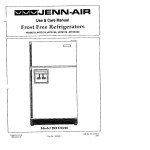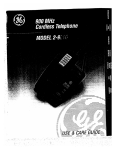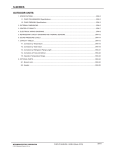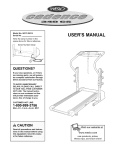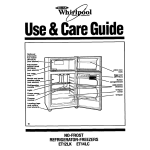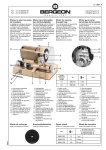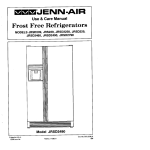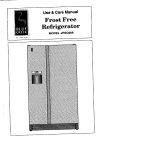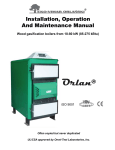Download Jenn-Air JRT199 Refrigerator User Manual
Transcript
mJENN.AIR Use & Care Manual Frost Free Refrigerators MODELSJRT1960,JRT2160,JRTD229, JRT199,JRT219,JRTF1960,JRTF2160 I Model Printed in U.S.A. 1996Jenn-Air JRTD229 PartNo._70304-1 Cat. No.STU1960UA 1/g6 Your Jenn-Air frost-free refrigerator was designed, engineered, and manufactured to the highest standards of quality and performance. Since this manual explains how you can obtain the best use of your Jenn-Air, it is essential that you follow the instructions carefully. Should you have any questions about using your Jenn-Air appliance, write to us. Be sure to provide the model number of your appliance. Jenn-Air Customer Assistance, c/o Maytag Customer Service, PO Box 2370, Cleveland, TN 37320-2370. THE MODEL YOU NAVE SELECTED MAY NOT HAVE ALL OF THESE FEATURES Automatic Ice M_ker Energy Saver and Automatic Switch Light Dispenser Bin RViinkR efrigernttr°; Crisper Cover Adjustable Glass Sealed Crisper Drawer Sealed Crisper Egg Caddy Dairy Compartment Model 2 Tender JRTD229 SHOWN 1. Use the three-pronged plug only with a grounding receptacle to provide protection from electrical shock. This appliance must be installed in accordance with the installation and grounding instructions on page 4-5. 2. Unplug your refrigerator before cleaning condenser, replacing a light bulb, or making any repairs. Any servicing shouLdbe performed by a qualified technician. 3. Lncase of power failure, minimize door openings. If powerfailure is of long duration, protect frozen food by placing blocks of dry ice on top of the packages, or check with a local frozen foods locker plant about temporary storage. Frozen foods which have thawed completely should not be refrozen. 4. Any electric service cord that becomes frayed or damaged should be immediately repaired or replaced. Never unplug your appliance by pulling on the power cord. 5. Your refrigerator should not be operated in the presence of explosive fumes. 6. Remove the doors from any out-of-use refrigerator to prevent child entrapment and suffocation. 7. DO not place fingers or hands on the automatic ice making mechanism while the refrigerator is plugged in. This will help protect you from possible Lnjury. Ltwill also prevent interference with moving parts of the ejector mechanism and the heating element that releases the cubes. If you are installing your new refrigerator yourself, please follow these helpful suggestions. 1. Remove base skids, i [-j I-J] IL 2. Remove all exterior and interior tape carefully and ,, ,_ll retain old tape. Make a small pad of this tape to pick off any remainingtape residues. This will eliminate the need to use dangerous Solvents of any kind. 3. Remove and discard the cantilever shelf packing clips located just above each shelf where they hook onto the frame. To remove the red plastic clip, wiggle it sideways and pull straight out. 4. Select a location for your new refrigerator away from any heat sources. Allow a free flow of air through the front base grille. 5. Your model should not be installed where the room temperature will go below 55°,=. because Jt will not run frequently enough to maintain proper temperature in the freezer. To enhance its appearance, maintain efficient performance and for proper function of the ice maker, your refrigerator should be level. Using a carpenter's level, check your refrigerator to make sure it is level front to back and side to side. The front wheels were adjusted at the factory so the cabinet would be level. However, jarring in transit, or standing the refrigerator on an uneven floor may cause the cabinet to appear unlevel. If leveling is necessary, remove the base grille and adjust: Models JRT199, JRT219, JRTD229 TUaN CLOCKWISE TO TOlock the cabinet in place, turn down one or bothlocking feet, located nearthe front wheels. Rear leveler feet are not required. I ._. ifthe floor is notlevel and it is necessary to raise the rear of the cabinet, we suggest rolling the rear wheels on to a piece of plywood or other xt_ shim material, r-, RAISE CABINET CORNER TURN COUNTER-CLOCKWISE To LOWER CABINET CORNER Models JRT1960, JRTF1960, JRT2160, JRTF2160: The refrigerator has 4 wheels and a leveling i I I _ , I I the cabinet. To adjust, turn the leveling screw clockwiseto raiseor counterclockwiseto lower. screw beneath each front corner at the base of _- Your refrigerator is designed to operate on a nominal 115 volt, 15 amp., 60 cycle line. There should be a separate, grounded circuit, serving this refrigerator only, DO NOT use ing plug for your protection against possible electrical shock hazards. It must be plugged into a grounding receptacle. Where a standardistwo prong waft is encountered, Your refrigerator equipped withreceptacle a three-pronged groundit is the personal responsibility and obligation of the cuetomer to have it replaced with a properly grounded threeprong wall receptacJe. DO NOT, under any circumstances, cut or remove the third (ground) prong from the power cord. DO NOT use an adapter plug, _ _L _ pQ_VER SUppLy CORO ._t. _-P.o.G _o,_,_ p_. • _u.D,_ T_ WALL .ECE.'.CLE $ OH pQV#_ _ORO ,,o_,_,_o.,E,_ o_oo,_oo_ TH_,N S_WN HE_t. • LOCATIQN O_ p_NG Your refrigerator may have been built with the doors hinged to the right or hinged to the left. Refer to the following instructions for door reversal. Phillips screwdriver End wrench (5/16") 5/16'r Socket and ratchet T25 Socket wrench Putty knife 1. Turn the fresh food control to OFF, unplug the refrigerator end remove all food from the interior. 2. Remove the handles from the doors and set aside. The bottom mounting screw on the lower door handle is covered with a cap. Carefullypry it out to expose the screw. The cap should be saved for reassembly after the handle is remounted. On the side (front) ofthe lower doorthat you are going to installthe handle,removethe smallround screwhole plug with puttyknife and press it intothecorresponding holeon the opposite side of the door. 3. Using a 5/16" socket and ratchet or end wrench, remove the screws from the upper hinge. Carefully lift the door (including the upper hinge) off of the center hinge and place iton a padded surface to prevent scratching. Avoid losing the spacer that was between the hinge and the cabinet top. 4. Using a putty knife, pry the plug button cover from the plastic bushing at the top of the door. Save the cover for future use. 5. Lift the upper hinge and the spacer washers from the door and install them at the opposite corner. 6. Position the plug button cover, saved from step 4, over the old hinge bushing and press it into place. 7. Pry out the 3 plastic plug buttons from the cabinet top and press them into the opposite corner. 8. Unscrew the hinge pin out of the center hinge on the top of the lower door. Carefully lift the lower door off the lower hinge and place it on a padded surface. If the metal hinge pin pulls out of the lower hinge when the door is removed, pull it out of the door bottom and press it back into the hinge. 9. With the T25 socket wrench and 5/16" socket and ratchet, remove the screws from the center hinge and spacer from the cabinet. Transfer the two screws from the left end of the divider bar to the right end. Installthe center hinge and spacer on the left end of the divider bar the same way it was installed on the right end. Tighten both screws until they are just snug, then turn them one-half turn more. 10. Pry the plug cover from the plastic bushing at the top of the lower door and press into the plastic bushing on the opposite side of the door. 11. Remove the base grille by grasping at both ends and pulling it straight out. 12. Remove the hinge cover by squeezing both sides together. 13. Use a 5/16" socket and ratchet to remove the two screws from the bottom hinge. Save the spacer. 14. Pull the metal hinge pin from the side of the lower hinge and place it, including the spacer washer, into the top hole. 6 15. Pry out the two screw hole plug buttons on the bottom left side of the top door and lower door. On some models, remove the door stops (metal plates) on the bottom of eachdoor and install them on opposite sides. Press in the plug buttons in the holes on the right side of both doors. 16. Set thelower door on the bottomhinge, making surethe hinge pinentersthe bushing in the door bottom. 17. While hoWtirtcjthe doer in a clesed positlen, take the canter hinge pin that was removed in step 8 and screw it through the left hole of the center hinge and into the bottom doorbushing. Make surethe long pin goes intothe bottom door and the short pin goes into the top door. 18. Set the upper door on the center hinge, making sure the hinge pin enters the door bushing. When you close the door, the gasket should hold it in place. 19. Making sure to use the same number of spacers that were originally used beneath the upper hinge, install the hinge mountingscrews. Beforetigbteningthesescrews, make sure the top of the door is level with the cabinet top, and the space between the door is equidistant across the entire front. Avoid over-tightening these screws. Tighten both until they are just snug, then turn them in another one-half turn. 20. Examine the door gasket all around each door, making sure no gaps are visible betweenthegasketandcabinet. Ifagapshows, trystretchingthegasketaway#om the door. The magnet will contact the cabinet surface. 21. Insta}]the handles on opposite sides of the doors as shown. 22. To replace the base grille, line up its spring clips with the square openings in the cabinet and tap each end in until the grille locks in place. Replace hinge cover. 23. Replace all food and return the fresh food control to its usual operating position. 17 j./ _ ..... J UPPER DOOR _ 7 " LOWER DOOR HANDLE I = II _J n Handle . ._,_ / I extension (some models) / I HANDLE [IF USED) EXTENSION I Your new refrigerator has two controls. One for regulating the temperature in the fresh food compartment and one for the freezer. The fresh food compartment and the freezer compartment controis are located at the top front of the fresh food compartment. Turn both controls to "No. 5" to start your refrigerator. 9 is coldest Saves Energy /_. \/ I" I $ " I ReducesExterior Moisture U m I The"No.9"freezercontrolsettingisrecommended for short term use only. _ 9 is coldest Your refrigerator may run for several hours when you first start it. This is normal and shouldn't be cause for alarm. TOstart" Changing either control will have some effect on the temperature of the other compartment. Refrigerat°rtc*° WARM: Refngerator too COI O: Set fresh food coctrol on "5_ Set frsezer contmt on '¢J" Tum_esh_,_to_e_ h_lherrtumbe_ Tum fresh f°°d c°nt(°t t° l_e:c /ower numb_. Turn freezer con_-olto next tn a day or two, you may decide that one or both compartments should be colder or warmer. If so, adjust the control(s) as instructed in the accompanying chart. F_zer_ WARM: Fteezer_oOOLD hlghernumbe K Turn#eezeroontro/tonext _wer number Refng eraterOFF Setfreshf°°dr_°ntroltoOFF. IMPORTANT: Except when starting, do not change either control more than one number at a time. Allow 24 hours for temperature to stabilize before resetting. At times, the front surfaces of your refrigerator cabinet may be warm to the touch. This is a normal function of your refrigerator. This feature prevents moisture from condensing on the outside of your refrigerator during humid weather. This condition may be noticeable when you first start your refrigerator, during hot weather, and during excessive or lengthy door openings. The Energy Saver switch controls a heater designed to prevent moisture acoumulation between the refrigerator and freezer door frame. During humid weather, moisture collects on objects that are cooler than the surrounding air. This condensation can be eliminated by applying a small amount of heat to the surface upon which the water accumulates. When the Energy Saver switch is on "Saves Energy", no heat is applied to the surface. It is saving both energy and money. If humidity increases and condensation appears, turn the Energy Saver switohto "Reduces Exterior Moisture". Be sure to turn the Energy Saver switch back to "Saves Energy" as the humidity drops to save energy. In areas of relatively high humidity, the Energy Saver Switch in the "Reduces Exterior Moisture" position will minimize any collection of moisture on the outside surface of the cabinet. For efficient energy use: 1. Besure the refrigeratoris level and ventilation around thefront grille is not blocked, 2. Check door sealsoccasionallyfor leakage, Check at various places,top, bottom, and sides. 3, Check the temperature;avoid unnecessarycold settings. 4, Keep the freezer near full capacity; less cold air is lost during door openings. 5. Let hot dishes cool before putting into refrigerator or freezer, 6, Cover liquids; if uncovered, the unit must work longer. 7, Clean refrigerator condenser coils at least twice a year. To maintain the natural flavor, moisture, and nutrition of fresh foods, we recommend that all dishes, trays, and containers of food be covered. tioned to suit your special needs. To remove a shelf, lift the rear straight up a fraction of an inch and pull straight out. To lock into another position, tilt the shelf with the front up. Insert hooks into desired frame openings the Adjustable cantilever shelves canand belet posishelf settle into place. Make sure it is securely locked at the rear. _li_ll 1 The Temp Control Drawer, between the top and second shelves, provides short term storage of fresh meats without freezing. This drawer will provide extra chilling only if the cantilever shelf that supports the Temp Control Drawer is in the 2nd, 3rd, or 4th shelf adjusting positions. Keep the drawer tightly closed at all times. The slidinglever on the back wall, above the drawer enables you to vary the internal temperaturesinsidethedrawer. Withthe leversetat the "Cold"position,thetemperature insidethe drawerwill becoolerandyou can storemostgoodqualitymeatsseveraldays. All meats or poultryshouldbe storedintheir originalstore wrappingsor in plasticbags to reducethe evaporationof moisturefrom them. To removethe Temp ControlDrawer, pull it out until it stops. Then applya littlemore pressure and pull completelyout. To use your wine rack fit it along either side of any refrigerator shelf and lay the wine bottle on the rack. III 10 ,,,/" The Sealed Crispers are ideal for storing vegetables and fruit. Keep your crispers tightly closed to insure freshness. Storing leafy vegetables, such as celeryand lettuce in plastic bags, reduces moisture evaporation. The crispers slide out for easy access to foods stored within. They are completely removable for cleaning (hand wash onty) or for use elsewhere fn your kitchen, The crisper cover also serves as a refrigerator storage shelf. To remove for cleaning, push up on the glass cover from underneath and carefully remove. The humidity control levers are located on the shelf above the crisper drawers. The slide control should generally be set at the "Low" setting for fruits and the "High" setting for vegetables. Occasionally, you may notice water droplets on the back wall. This is normal. Defrost water isused to maintain humidity level and helps keepfood fresh longer. Excess water drains into the defrost pan beneath the cabinet and evaporates. 11 Your model has an egg caddy that fits securely on a door shelf. This egg caddy can be removed and carried to your working area. Door gaskets are magnetized to insure an air tight seal all around, These gaskets cling to the cabinet front, once the doors are closed to within their magnetic range. uo. oosve as teo oer position on the door. Lift the shelf straight up until it clears the retainerson the door liner and pull straight out. Reverse this procedure when replacing a shelf. Some models have a bottle retainer located on the lower refrigerator door shelf. It preventstall bottles from falling out when the door is opened or closed. The bottle retainer can be adjusted to any position on the shelf by sliding sideways. All models have a Shelf Tender located on one of the refrigerator door shelves. It provides upright storage for packages or bottles. The Shelf Tender can be adjusted to any position on the shelf by sliding sideways. 12 To maintainthenatural flavor, moisture, and nutritionoffrozen foods, and toprevent freezer burn, we recommend that all foods be wrapped or sealed properly. end up approximately 1/4"(2) push the shelf to the right as far as it will go into the sockets (3) lift the left end up approximately3"and (4) pullthe right end barsout of the socket in the side wall. Some models have an expandable-width freezer shelf which adjusts sideways to open up a full-height space for tall packages, such as pizza. The right side of the shelf is supported by a wide leg that slides sideways in channels on the underside of the shelf. The sheff can also adjust to two heights. This requires removing the shelf from the freezer, slidingthe leg out of the channels, re-inserting it in the alternate height position and returning the shelf to the freezer, hanging on the alternative T FREEZER SHELF _ "_-_ ] _ ._ __ g//////I/I panded fully to the right wall surface, unless vertical storage of narrow packages is desired.) hooks (usua"Y' the dght supp°rt se=i°n w"'beex"L Some models have a tilt out basket on thelower shelf of the freezer door. Tiltingthe basket forward by its upper edge provides easy access to packages, A slight push upward will tilt the basket back to its proper stored position. 13 __ _ _ _ li ]l IIl\\\\\\\\\_\_;.;;_-----------------_J_-.,_ 11 f- .P) Ill[ Your refrigerator comes equipped with ice cube trays and a storage bin (on most models.) To release frozen cubes, hold the trays upside down and twist both ends. Some models are designed so an Automatic (oe Maker can be easily installed whenever you want it. Order the ice maker kit number shown on the label on the cabinet back. The kit contains installation instructions, water connection instructions and other information concerning the ice maker operation. The water inlet tubing assembly required to complete the water connection to the water valve is located in the crisper drawer in a bag. Connect the ice maker to the water supply as instructed in the separate Lnstructions,furnished with the refrigerator. The automatic ice maker is designed to furnish a continual supply of ice cubes. The amount of ice produced depends on the temperature in the freezer section of your refrigerator. The colder the freezer section, the more ice is produced. We suggest you start with your refrigerator and freezer controls at their mid settings. In most cases, this is satisfactory. If the door to the refrigerator or freezer is opened frequently or temperatures in the kitchen are abnormally high, a colder setting may be necessary. After your model has been installed and the water supply connected to the ice maker, it may take 8 to 12 hours before the ice maker furnishes any usable ice cubes. The first one or two harvests will probably contain undersized and irregular cubes because of air in the supply line. The initial harvest may also contain impurities from the new water supply piping. Therefore, all cubes from the first two or three harvests should be discarded. Under certain rare circumstances, ice cubes may be discolored, usually appearing with a green-bluish hue. The cause of this unusual discoloration is apparently a combination of factors such as certain characteristics of local waters, household plumbing and the accumulation of copper salts in an inactive water supply line which feeds the ice maker. Continued consumption of such discolored ice cubes may be harmful to health. If such discoloration is observed, discard the ice cubes and contact the dealer from whom the ice maker or refdgerator was purchased. Ice cubes that have been in the ice storage for a considerable length of time may pick up oft-flavor taste, stick together, and gradually become smaller. We suggest that these cubes be thrown away. We also suggest using an open box of baking soda in the refrigerator for food odor absorption. Certain sounds may accompany the various cycles of the ice maker. Examples are: (1) the motor may have a slight hum, (2) the cubes will rattle asthey fall intoan empty storage bin, and (3) the water valve may click or "buzz" occasionally. All of these sounds are normal and should be ignored. 14 Note: When dispensing ice cubes, it is importantthat you use only the ice supplied by thisicernaker. Ice from anyothersourceoouldcauseanicejam. Ifthis happens, remove and discard all ice from the storage bin and any ice lodged in the ice chute. AUTOMATIC ICE MAKER Your automaticice maker islocated near the top of the freezer compartment behind the Ice Access Panel. To gain access to the ice / SENSOR ARM p/ _ The ice maker has a wire sensor arm that is making mechanism, connectedto a shut-off liftswitch. the Ice This Access armPanel. stops _ OFF the mechanism when the ice cube storage bin isfull, and restartsit after several ice cubes have been used. You can use the stop arm to stop all productionof ice at any time. All you need to do is raise the arm into the OFF position. The ice maker should be turned off (arm up) when; 1. Ice storage bin is to be removed for extended period of time. 2. Refrigerator is not to be used for a considerableamount of time, such as vacations. Also, turn off the water supply to the ice maker in this instance, if practical. 3. Water supply is to be shut-off for several hours. the freezer compartment cooled Water fillsthe emptycubehas mold (Fig.to 1)freezwhen ing temperature. Cold air is forced direCtly over mold. _FILL _ i When frozen, the cubes are rotated up and out of the mold (Fig. 2). The sweeper arm 1 ejects them into the ice storage bin below. Fig. | frozen cubes. Fig. 3 15 =_" ICE ]..,_----ICE BIN 2==J===_==_ d_"'_ However, the mold has been refilled and cubes frozen so the new supply is ready when needed. As soon as ice is removed from the bin,the sensorarm signalsthat more is needed. The ice maker resumes operation by eiecting ready-and-waiting p'- ,_-_1_,_. The sensor arm (Fig. 3) senses when the bin is full and signals the ice maker to stop ejecting more cubes, TueE IL_¢_'_ _ Lift the front of the Automatic Dispenser bin and pull it straight out. Wash the bin occasionally in mild soap and lukewarm water. To replace the bin, push it all the way back until the bottom of the bin is behind the raised edge at the front of the shelf it rests on. Make sure the tabs, at the back of the bin, that turn the spiral auger are positioned between the prongs from the auger motor. Prevent ice cubes from missing your glass by holding it as high as possible (just below the ice chute). Press the glass against the padded lever at the left side of the fountain. To stop dispensing ice, release pressure just enough to stop the dispenser motor and leave the glass in place to hold the door open until ice stopsfalling. With a little practice, you will learn to anticipate when to release pressure to prevent an unwanted dispense of ice, which occurs each one and one half seconds. After installation, it may take 1 to 2 days to fill the Automatic Dispenser bin with ice cubes. To dispense water, press a container against the padded lever at the right side of the fountain. To stop the water flow, release pressure. To minimize splashing, hold the container as high as possible. When you first operate your dispenser or after reconnecting water to your refrigerator, air will escape from the dispenser for a few minutes before water begins to flow. Draw 10 glasses of water and empty them in the kitchen sink. This will insure complete filling of the reservoir with fresh water. 16 Do not discard water into the grille at the bottom of the fountain. This is a spill area, not a drain, Normal spil}s wi}lbe evaporated in the recessed area below the spil_shelf grille. Excessive spills should be removed with an absorbent sponge or cloth. The spill area should be cleaned occasiona}ly. The push button light switch is located behind the panel at the top on the right side of your fountain. For replacement, use a 120v, 7 watt bulb. A chi}dproof }ock is located behind the panel at the top on the left side of the dispenser. This push button switch will turn your ice and water dispensers on or off. 17 It is recommended that you disconnect the power cord before cleaning. Your refrigerator can be rolted out for cleaning. Turn the levelers, at each front corner of the cabinet,counterclockwise untilthey turn freely. Then pull the cabinet straight out. Note: If you have an Automatic Ice Maker installed, we recommend that you turn off the water supply before moving the cabinet. After cleaning behind your refrigerator, push it back and turn the levelersclockwise until they touch the floor and lock the cabinet in place. Use mild soap and water, DO NOT use scouring powders, automobile wax, or furniture polish. Rinse with clear water. Door gaskets may be cleaned with soap and water, a baking soda solution, or mild scouring powder. Clean both compartmentsand inner door panels with mild soap and water. Do not use an abrasive powder, solvent, polish cleaner or undiluted detergent. You may notice a slight discoloration appearing at the top and near the center of the back wall of the fresh food compartment. This is no cause for alarm, but it should be cleaned off periodically. When cleaning a glass cantilever shelf, you can remove it and submerge the entire assembly in warm water. Never use hot water. Always allow glass to warm up to room temperature before immersing in warm water. 18 Defrost water drains into a shaJIowpan beneath the /'/_'/.-_ _ midity, water could remain in the pan. This pan should be cleaned once a month with a strong solution of soap and water. cabinet anddefrost evaporates. During of high To remove pan, grasp theperiods base gri}le on huboth ends and pull it strafghtout. Slide the pan out from j_.___l 1111 To replace the defrostpan, positionthe side flanges to underneath the cabinet. fit over the slide rails and push it in until it stops. SUPPORT RALL_ _,FROiT PAN_ _ To replace the base gdlte, line up the spring cfips on the base gdlle with the square openings on the refrigerator. Tap each end in until the base grille locks in place. To allow your refrigerator to run more efficientiy, the base grille and the area around the condenser should be cleaned at least twice a year. The area aroundthe condenser can be cleaned whenever the refrigerator is moved during routine house-cleaning. Unplug the refrigerator and move it away from the wail Vacuum the condenser and cabinet normally sits. Plug in the reffigerabase grille area and the area where the _OEF"OST tor after cleaning. I _A, _o_._ O_,E_ ""_.S_G,_Le TOoJeanthe base grille, grasp both ends and pull straight out. After cleaning, replace the base grifle. To replace the base grille, line up the spring clips on the base grille with the square openings on the refrigerator. Tap each end in until the base grille locks in place. 19 It is recommendedthat you disconnectthe powercord before replacing light bulbs. Always use a 40 watt, standard base, appliance type bulb when replacing a light. Replacefreezerbulbby:(1) usingtwohandsspreadeachsideof the lightcoveroutward and pullto thefront;(2) unscrewand replacebulb;(3) pushrighthandsideof lightcover towardbackof freezer engagingthe tab intothe slot. Then pushleft side towardback engagingthe left tab into the slot. If you wi(ibe gone for a month or less, leave the control knob at its usual setting. During 7ongerabsences, (a) remove all food, (b) disconnect from electrical outJet, (c) clean the refrigerator thoroughly, including defrost pan, (d) leave doors open to prevent odor formation, e) turn off supply water for ice maker, if pra_ical. 20 Problems? Save yourself the inconvenience of unnecessary service calls; check these first: Refrigerator runstoo frequently. • Frequent running provides more stable temperatures. • Too many door openings. • Prolonged door openings. Refrigerator runs too long. • Under normal conditions, due to larger size and colder temperatures, modern refrigerators run a greater percentage of the time. • Prolonged or frequent door openings, • Condenser needs cleaning. • Poor air circulation around condenser. Refrigerator won't run. • Temperature control turned to OFF. • Power cord not plugged in. • No power at electrical outlet. • House fuse blown or circuit breaker tripped. Cabinet vibrates. • Cabinet not level. • Weak floor. Warm air from cabinet bottom. • Normal air flow for condenser circulation. Front cabinet surface warm to touch. • Special design to prevent condensation during periods of high humidity or frequent door openings. Moisture on outside surface. • Hot, humid weather increases condensation. When humidity drops, condensation disappears. During hot humid weather, turn the Energy Saver switch to "Reduces Exterior Moisture". Sizzling sound in freezer. • Normal sound caused by defrost water dripping on defrost mechanism. Water on floor under cabinet. • Defrost pan missing orn ot positioned correctly. 21 Water in fresh food compartment s Cabinet not level. • Drain tube plugged. bottom. Noisy operation. • Fan noise perfectly normal in frost-free refrigerators. You may not be used tothis if previous model was manual defrost, • Cabinet not level. • Weak floor, • Defrost pan not positioned correctly. Odor in cabinet. • Defrost pan needs cleaning. • Food left uncovered, • Interior needs cleaning. Foods dry out (Fresh or Frozen). • Packages not wrapped or sealed properly, • Cdsper not tightly closed. Fresh food compartment too cold. • Refrigerator control set too cold. Fresh food compartment too warm, • Refrigerator control set too warm. • Freezer control set at coldest position. • Prolonged door openings. Freezer compartment too warm, • Freezer control set too warm, • Prolongeddoor openings. Ice cubes evaporate. • Cold air moving over ice cubes causes shrinkage. Automatic ice maker not operating • Stop arm in OFF position. • Water supplyturned off. • Water pressuretoo low. • Freezer too warm. Ice Dispenser not operating. • Ice jam in the dispenser, • Ice maker not operating, 22 Water Dispenser not operating. • Water suppiyturned off. • Water pressuretoo low. Cabinet light not working. • Bulb burnedout. • No powerat outlet. Water appears on back wall of fresh food compartment • Normalfunctionduringdefrostcycle. Water flowstothe bottomof the compartment and drains into the defrost pan. If You Need Service • Callthedealerfromwhomyourappliancewaspurchasedor theauthorized JennAir Service Contractor listed in the Yellow Pages. Your Jann-Air Contra_or can provide better and faster service ifyou can accurately describe problems and give model and serial number of the appliance. Be sure to retain proof of purchaseto vedfy warranty status. Refer to WARRANTY for further information of owner's responsibilities for warranty service. • If the dealer or service company cannot resolve the problem, write to Jenn- Air Customer Assistance, c/o Maytag Customer Service, PO Box2370, Cleveland, TN 37320-2370, 1-800-688-1100. (U.S. and Ontario) or 1-423-559-3646. • Use and care manuals, service manuals, and parts catalogs are available from Jenn-Air Customer Assistance, c/o Maytag Customer Service. All specifications subject to change by manufacturer without notice. 23























